Drury University, Springfield, Mo., has added new card readers in four campus buildings to provide greater security as well as 24-hour access. Before installation of the readers, which began in May, students didn’t feel safe because some doors were often left open late at night.
Previously, students had to call security to gain admission. As one student said: “It’s nice because you don’t have to sit around waiting for security anymore. Sometimes when you can’t get in really late at night, it’s not exactly the safest thing if you are just standing there waiting by yourself.”
Read more here.
Students at Stanford University can now charge up to $1,000 at campus locations using just their student ID cards. The plan is designed for students with money needs who may be waiting for additional financial aid. In addition, they will have to pay off their account by the end of each quarter.
However, any student can participate in the program, making his ID usable at most campus eateries, photocopiers and printers, in addition to the bookstore. The new plan, implemented Sept. 1, eliminates most of the previous debit functions that were in place for student IDs.
“My dad loved it because I don’t have to keep track of my receipts and stuff and be asking for money for books all the time,” said one student.
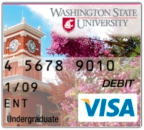 The tale of Washington State University banking partnership and ID card
The tale of Washington State University banking partnership and ID card
By Andy Williams, Associate Editor, Avisian Publications
When Washington State University in Pullman went looking for a banking partner a couple years ago, administrators had some strong ideas of what the program needed to offer.
“WSU was approached by a number of institutions who wanted to provide banking services for our CougarCard holders,” says Craig Howard, director of WSU’s Administrative Services Information Systems. “However, the offerings always fell short in one way or another.”
“We had always known that a program would need to meet some fairly stringent criteria before we would seriously entertain a banking relationship for the CougarCard,” says Howard. “The program would need to provide an instantly issued Visa or MasterCard logo debit card, no two week wait period, and we wanted the program to be opt in with a brick and mortar presence,” adds Howard.
After the requests for proposals went out, Howard says the university brought in two banks for final discussions, one which was U.S. Bank.
“The instant issuance was pretty tough criteria but U.S. Bank told us they’d be doing instant issuance in the next few months,” says Howard. The other bank had no plans to do instant issuance.
“WSU awarded the bid to U.S. Bank and we were able to scrunch up a little space, 650 square feet next to our card office.” One door literally separates the bank from the card office.
The university started issuing its PIN-based debit cards in 2007, Howard says. To do so it had to make some changes to how data was encoded on the CougarCard. The card would still be used for meal plans, the school’s declining balance program Cougar CASH, facility access, sports passes for athletic events with the added PIN debit functionality. The university had negotiated for the card to be used at 32 off-campus merchants.
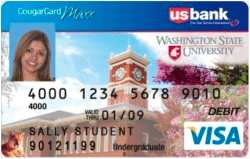
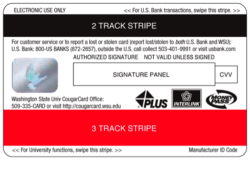

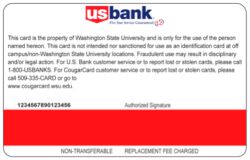
The CougarCard comes in two choices, the standard card has just one red mag stripe on the back. Everyone, the school’s 18,000 students and 5,000 faculty and staff, receive the standard card. But if they choose the CougarCard Maxx, which involves opening an account with U.S. Bank, they get an enhanced version, says Howard. U.S. Bank started offering this card in January, says Howard.
WSU and U.S. Bank made several changes to the program including:
Moved the Maxx card printer and software into the on-campus U.S. Bank branch adjacent to the CougarCard Center.
Developed a “flat,” non-embossed Maxx card.
Added a second, black magnetic stripe to the CougarCard Maxx to eliminate the need to populate any banking information into the CougarCard System.
The black mag stripe is used with the banking account as a normal debit card and the red mag stripe is for everything on campus, the resident dining account, Cougar Cash, which works in vending machines, door access for residence halls, admission to football games or admission to the recreation center, says Howard.
“We also redesigned the standard CougarCard to provide a complementary format for the CougarCard Maxx. All of these changes and innovations have caused us to change our marketing and internal procedures to keep up with the evolution of the CougarCard program. We’re in the final stages of those changes now as we’re working with our local merchants to shrink our Cougar CASH program to only include on-campus merchant locations for the next academic year.”
Off-campus program reduced
What he couldn’t have anticipated was the disappointment by some students, of losing 22 of 32 off-campus businesses that could accept the new card. The reason for the move was Visa’s non-compete clause that meant the school’s standard campus card account couldn’t compete with Visa for off-campus business.
The school was able to negotiate the definition of “off-campus,” and was able to include some merchants in close proximity to the university, says Howard.
One of the key reasons the university agreed to the new contract, he adds, was that the school is just eight miles from a major shopping area that most students utilize. The problem? That shopping area is in Moscow, Idaho, and the CougarCard couldn’t be used across state lines without the university having to comply with banking laws.
There were other issues as well. Challenges started to crop up and the cost to the university started increasing. “Although it was a nice program for students it didn’t yield any margin for us,” says Howard. “As we analyzed it, the program was becoming less viable. We had also started seeing off-campus sales decline. Last year for the first time it was becoming harder and harder to answer the question that ‘my student has a debit card, why put money into Cougar Cash?’”
Adds Howard: “It didn’t make sense to be a competitor of Visa.”
Cards obtained quickly
“Students have their photos taken in the card center and the bank prints out the CougarCard Maxx. If they don’t have a bank account, or if they’re not interested in a CougarCard Maxx we print the standard CougarCard and give it to them,” says Howard.
Going into the summer, WSU issued some 700 Maxx cards. “Now we’re going through orientation, and we’ve issued about a thousand. It will probably be close to 2,000 students carrying the Maxx card by the time school starts,” he says.
More importantly, the program is optional. “Students don’t have to get a Maxx card or bank with U.S. Bank unless they choose to.”
Do you want prox with that, too?
Now, the university is taking the Maxx card a step further. It has begun a pilot program to include a prox chip on the card for those students, faculty or staff who need access to the school’s more secure areas, such as computer labs or server rooms. The pilot began the first week of July.
“The goal is to avoid issuing two cards or making people carry two cards,” says Angela Ralston, operations manager for U.S. Bank Campus Banking. “With our Maxx card replacing their ID card, we needed to be able to replace it wholly, performing all the functions the standard campus card did.”
“The mag stripe on my CougarCard Maxx has gotten me through the back door of the building and my office door but to get into the server room, I need a prox card. Now with the prox chip on my Maxx card, I have one card that really does do everything,” says Howard.
The card will be distributed to other students and staff who need access to buildings like the university’s main server facility. “We also only have prox access for the cashier areas, the vault rooms and certain labs,” says Howard.
Why prox at all? Mostly it’s for convenience because Howard doesn’t think the card is that much more secure. “Often times it’s just easier to get through the door without doing anything with your hands. For example, you might be loaded down with books and “as long as you can get the card close to the reader” you can get in, says Howard.
Right now, just a hand-full of students have need of a prox card. And again, it doesn’t matter whether you have a Maxx card or CougarCard not tied to a U.S. Bank account, you can still get a card with the prox chip if you need one with that capability, says Howard.
One stumbling block for the prox cards is that they’re more expensive than one with just a mag stripe. “We pay about $4 for a duo HID prox card with mag-stripe and 42 cents for a preprinted magnetic stripe card,” says Howard.
He anticipates issuing 20 to 30 prox cards in the next six months. “It’s a small group because they only have certain facilities that require prox but that makes it an attractive place to do a small pilot,” says Ralston.
“We plan to make this available at other universities once the pilot has proven successful,” adds Ralston.
“One of the reasons we chose to do this pilot is a demand from the schools. If they offer prox technology on their standard cards, they want the bank card to be backward compatible. They want to be able to offer everything else on one card. That’s what drove us,” says Ralston.
 Recycling can provide a selling point for cards, but reclaimed plastic often comes in less-than-pure shades of white that can drive away card-industry decision makers.
Recycling can provide a selling point for cards, but reclaimed plastic often comes in less-than-pure shades of white that can drive away card-industry decision makers.
“The biggest concern among card manufacturers is being able to offer a consistent color,” says T.R. Mitchell, vice president of New Wave Plastics, a Medina, Ohio-based recycler.
To overcome the problem of impure whites tinged with yellow or gray, New Wave is working with Bolatron Performance Products, a Newcomerstown, Ohio-based sheet manufacturer that supplies the card manufacturers with print stock.
“Through this partnership, we have developed a program where we offer 80,000 pounds of consistent loads so we don’t have the problems of discoloration with recycled cards,” says Mitchell.
Yet skepticism of recycling remains. “It definitely makes the whites look ugly,” says Bill Crawford, vice president of sales and marketing for Franklin, Ohio-based Waytek Corp., a materials and coatings supplier to card manufacturers, and a board member of the Princeton Junction, N.J.-based International Card Manufacturers Association.
“Everybody likes to print on gorgeous virgin white stock and when you start to use recycled PVC in your stock it will look gray and streaky,” Crawford maintains. “Are you OK with your logo on streaky gray stock?”
Off-white card stock also can change the shades of the colors printed upon it, thus changing the look of company logos, says Shane Cunningham, marketing communications manager for Digital Identification Solutions LLC, which provides printers and software for creating secure credentials.
Other than color, recycled polyvinyl chloride–or PVC for short–performs almost exactly the same as virgin PVC in card manufacturing and processing, industry executives agree.
Recycled PVC has yet to establish a significant share of the market but could increase in popularity as consumers become more environmentally conscious. “We have been training society to recycle for many years,” notes Mitchell.
Crawford acknowledges that recycling could provide a selling point in some markets, such as gift cards, and suggests that marketers could capitalize on the discoloration as a mark of recycling authenticity. “There are some specialty applications where green is important and looks are not,” he says.
In such cases, a company marketing department could justify the expense of recycled PVC, which costs more than virgin PVC, Crawford says. Even when demand exists for cards made of recycled plastic, recycling the cards themselves might not make sense, according to Crawford. Driving two blocks to recycle a card would cause greater environmental harm than throwing away the card, he says.
Still, some are finding ways to make recycling the cards pay off. “We have set up a few programs with different manufacturers, where they will send cards to us and we will reprocess them and send them back,” Mitchell says. “However, the cards cannot be intermingled; they must be 100% PVC to do this.”
Crawford suggests the alternative of making cards from PVC used to make plumbing pipes or house siding. The use of PVC in building materials far outstrips the amount of PVC used in cards, he says.
In fact, he questions the need to recycle cards because of their relatively small amount of PVC. “The card industry use of PVC is insignificant compared to the packaging industry, the construction plastic–those markets are huge compared to the small amount of plastic you’re carrying in your wallet,” says Crawford.
Cunningham says his company has not received any requests for recycled PVC. He calls cards of recycled PVC “more of a PR thing than anything else.”
Texas A&M University, College Station, has expanded its suite of iPhone and iPod Touch applications to enable students to see course offerings, campus maps and directions to classes and information about university events.
TAMUmobile, which was first released in June, already includes a directory for finding currently enrolled students, faculty and staff, news about the university, TAMUtv, which provides access to university and student videos, and athletics, which shows scores, news and schedules for all Aggie sports.
The suite was initially developed by TerriblyClever Design, a company later acquired by Blackboard.
In two freshman residence halls at Susquehanna University, Selinsgrove, Pa., all former coin-operated laundry machines have been converted to eSuds, a coin-free system that allows students to swipe their ID cards, or debit/credit cards, to do their laundry.
When eSuds, provided by USA Technologies, was first installed all old machines had to be replaced with newer models that could handle the new technology. There is also a Web site where a student can go to check laundry machine availability and have an email sent when a washing machine or dryer becomes available.
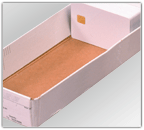 Sustainable options are still a ways off
Sustainable options are still a ways off
By Ed McKinley, Contributing Editor, Avisian Publications
Polyvinyl chloride–or PVC for short–dominates the nation’s plastic-card market despite efforts to find more ecologically friendly materials. Cards made of 100% PVC account for perhaps 90% of all the plastic cards made in North America, according to card-industry executives. Most of the other 10% are composite cards with polyester cores sandwiched between layers of PVC.
“PVC has been honed in our trade for over 30 years for print-grade stock–everything is built around PVC,” says Bill Crawford, vice president of sales and marketing for Franklin, Ohio-based Waytek Corp., a materials and coatings supplier to card manufacturers, and a board member of the Princeton Junction, N.J.-based International Card Manufacturers Association.
Low price makes PVC the material of choice for most cards. It sells for a dollar a pound, yielding cards that cost about four cents each, much less than cards made from other materials, says Shane Cunningham, marketing communications manager for Digital Identification Solutions LLC, which provides printers and software for creating secure credentials.
The price of a card tends to increase as the environmental friendliness of its construction increases.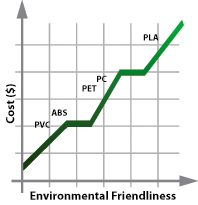
The durability of a card tends to decrease as the environmental friendliness of its construction increases.
The advantages of PVC don’t end with price. Manufacturers find it relatively easy to print on PVC and to glue magnetic stripes, Crawford says. Card makers can laminate, hot stamp and die cut PVC, it accepts dye from a variety of printers, Cunningham says. And it is the only card material that “self extinguishes,” meaning that if it catches fire it puts out the flame, he adds.
But 100% PVC cards don’t last as long as cards made with some other materials, says David Ogonowski, an estimator who handles product development for Denver-based CPI Card Group. That’s why manufacturers make composite cards with polyester cores and PVC on the outside, he says.
Depending upon how the public uses cards, 100% PVC versions last two to four years, and composite polyester and PVC cards last four to six years, says Mark Degan, corporate marketing manager for Cornelius, N.C.-based ColorID LLC. In tests on specially designed machines, pure PVC cards break after an average of 30,000 to 40,000 flexes, while polyester survives more than 55,000 flexes, Crawford says.
Composite PVC and polyester cards also withstand heat and cold better than 100% PVC cards, says Crawford. Putting photos and birthdates on driver licenses and ID cards with desktop printers can require heat, so those users often choose composite cards, he continues. Credit cards don’t require personalization via desktop printers, so 100% PVC works well for them, he notes.
PVC is good for cards, but some say bad for the environment
Still, not everybody loves PVC. While winning the trust of the card industry, PVC has earned the ire of environmentalists. “PVC is the single most environmentally damaging of all plastics,” says the Web site of Washington-based environmental group Greenpeace. The organization advocates phasing out PVC because producing it creates the deadly poison dioxin as a byproduct. Burning PVC also can release dioxin into the air, Greenpeace says.
Environmentalists also point out that PVC is not biodegradable. In other words, it will not break down in landfills, making it an objectionable material, they say. Some groups have branded PVC acceptable for long-term use in products that include plumbing pipes and house siding, but contend the material should not find its way into cards used for just a few years.
Environmental concern over PVC is spreading to the general public, says Daniel Gilliland, business development director for Lowell, Mass.-based Mirel, a supplier of bioplastics. The industry is thinking hard about “green” materials “due to card issuers seeing pressure from consumers,” he says.
“Retailers, such as Target and Wal-Mart, and card issuers, such as Visa, MasterCard, Discover and American Express, are pushing for green solutions to market to their customers,” agrees Brad Paulson, founder of Thor Engineering, a Northfield, Minn.-based consulting company, and ICMA Standards Representative.
The plastics industry has responded by creating biodegradable PVC cards. An additive to the cards attracts hungry microbes that break down cards in nine months to five years, industry observers say. It shares most of PVC’s good qualities in the manufacturing process, according to tests by card manufacturers. But it has been available in cards for less than two years, Crawford says, describing the material as in its infancy.
“We’re at the mercy of consumers,” Crawford says of biodegradable PVC. “At the end of the lifecycle, are you going to recognize a card in your wallet is bio PVC and you’re going to do something different with it than you did with your cards that aren’t bio PVC?” Crawford asks.
Biodegradable PVC costs slightly more than regular PVC and some fear that as it degrades it releases harmful toxins into the soil. Regardless, for some card users, making PVC biodegradable will not be enough because manufacturing it still requires petroleum and thus fails to qualify as sustainable.
Replacing petroleum with renewable sources for card materials
The search for renewable materials has led to cards made from polylactide acid–or PLA–mostly from corn in the United States and from sugar cane elsewhere. “We’ve tried it with potatoes, we’ve tried it with wheat, and corn does pretty good,” says Crawford. “In a few years we might be using something else.” Crawford’s company, Waytek, does not offer PLA but does make adhesives to bond the PLA to PVC.
PLA advocates, including Brian Glasbrenner, business director, films and cards, for NatureWorks LLC, a Minnetonka, Minn.-based provider of PLA, say the material has the potential to seriously reduce environmental problems.
“The environmental attributes can be really significant when considering something as large as the transaction card industry–which produces something like 19 billion cards each year, says Glasbrenner. “If just 40 million of these PVC cards were converted to PLA,” he says, “it would give you the fossil energy savings equivalent to almost 39,000 gallons of gasoline, and the greenhouse gas savings equivalent to driving a car 1,200,000 miles.”
Sustainability can provide a convincing argument for PLA among many consumers, but the cards themselves disappoint many in the card business. Cunningham cites problems with discoloration–either a slight gray or yellow tinge–that can reduce the clarity of the images printed on the cards.
Before processing, corn-based cards are susceptible to heat.
“You put corn sheets in a truck and send them three states away, they arrive and it’s a solid block of plastic,” says one source who requests anonymity. “Then you read on the tech data sheet that you’re supposed to keep it refrigerated.”
PLA cards need a PVC surface to work in dye-sublimation printers, adds Cunningham. Gluing a magnetic stripe to PLA can present challenges, Crawford adds. Inconsistency plagues PLA cards, according to another industry executive.
Cost is also an issue as PLA cards cost about 14 cents each, compared with four cents for a PVC card, Cunningham says, noting the difference can add up for issuers ordering hundreds of thousands of cards. “We’re still a very cost conscious society, especially now during a recession,” he says. “Everybody is going green if doesn’t cost more.”
Though sustainable, PLA cards fall short in another way, according to Crawford. “PLA cards are seldom recycled,” he says. “They hate PLA in the recycle stream,” he says.
PVC is hard to beat
However, contrary to what some recyclers believe, PVC can be recycled. Recycled PVC works just about as well as virgin PVC in the manufacturing process, but cards made of recycled PVC often appear gray and cost slightly more than virgin PVC cards, Crawford says. Making a card of recycled PVC requires less energy than using virgin PVC, but the recycled-PVC cards cost more, Crawford says.
Besides turning to recycling, the search for greener cards has precipitated inquiries into other types of plastic.
Still, not one of the alternative plastics stands above the others or above PVC in all three criteria of sustainability, processability and functionality, says Tom Mucenski, business manager, card films for Gordonsville Va.-based Klöckner Pentaplast, a supplier of plastic films. His company has tested a number of plastics for those three characteristics.
Another study of eight common plastics, conducted by Waytek, indicates PVC requires the least energy to produce and that making PVC results in the second-lowest greenhouse gas emissions, Crawford says. The tests did not point to any one superior type of plastic, a result echoed in later studies by Thor Engineering.
“It will be quite some time before alternative green plastics meet the physical requirements and pricing provided by PVC, which makes it difficult to provide reliable and cost-effective ‘green’ cards,” says Thor’s Paulson.
 |
PVC – Polyvinyl chloride Most common material used in North America for ID cards. OTHER APPLICATIONS: pipes for construction industry, cling films, juice bottles and food packaging, etc. Plastic Identification Code 3. |
 |
PET (also called Polyester) – Polyethylene terephthalate Used in combination with other materials such as PVC to add strength to plastic cards. There are various forms of the plastic resin or polyester as it is called in the textile industry. OTHER APPLICATIONS: beverage bottles, flexible food packaging, thermal insulation, textiles and boat sails. Plastic Identification Code 1. |
| Composite (also called Poly-Composite) Plastic cards labeled composite most often consist of PET at the core with PVC outer layers. PET increases the card’s durability while PVC keeps it low cost and easy to print on via standard dye sublimation card printers. |
|
 |
ABS – Acrylonitrile butadiene styrene Most common material used in Europe for ID cards. OTHER APPLICATIONS: pipes for construction industry, automotive parts, golf club heads and toy Lego bricks. Plastic Identification Code 7 (shared with PC and others). |
 |
PC – Polycarbonate Commonly used in ID cards that are personalized via laser engraving techniques. There are numerous types of PCs that are used frequently for injection molding processes. OTHER APPLICATIONS: single use and reusable drinking bottles, CD/DVDs, tubing and Apple computers. Plastic Identification Code 7 (shared with ABS and others). |
| PLA – Polylactide acid Biodegradeable polyester made from renewable sources such as corn and sugar cane. Marketed for plastic card use under the name corn cards but only nominal use to date. OTHER APPLICATIONS: medical sutures, stents, plastic cups and food packaging. |
ABS, PET and others challenge PVC
One plastic, called acrylonitrile butadiene styrene, or ABS, may someday undercut PVC on price in North America, says Cunningham. ABS costs less than PVC in Europe, but U.S. manufacturers don’t make ABS because of their focus on PVC, he says.
Adding the transportation costs from Europe or Asia makes ABS more expensive here than PVC, he continues. Although ABS is more durable than PVC, it can’t withstand direct-to-card printers and instead requires retransfer printing, says Cunningham.
Meanwhile, some card industry executives are turning their attention to polyethylene terephthalate, or PET, as a card material because Americans recycle so many milk containers made with PET or with amorphous polyethylene terephthalate, called APET, and oriented polyethylene terephthalate, called OPET. All offer more strength than PVC but present personalization challenges and cost more than PVC, Crawford says.
Polyethylene terepthalate glycol, or PETG, has gained popularity as a card material in Europe and Asia, Crawford says, and yields cards that look as good as PVC. Environmentalists consider PETG green because incineration presents no problems, he notes, and its lamination temperature is lower than that of PVC.
Europeans and Asians also have taken to polycarbonate, or PC, which incinerates to water and also offers durability, resists heat and accepts laser imaging, Crawford says. High cost presents a drawback, he notes.
The olefin family of plastics, including polypropylene, or PP, and polyethylene, or PE, has many variations and could become an alternative, Crawford says. Among types of resins captured in the recycling system, high-density polyethylene, or HDPE, places second in volume, and PP is third, he says. Olefins are light in weight, which reduces transportation costs, he adds, while noting the difficulty of printing on olefins.
Polyhydroxyalkanoate, or PHA, is a naturally occurring plastic made in bacteria cells, Crawford says. Natural enzymes can digest the material and thus return it to nature, he says.
While most of the industry explores the world of plastics for card materials, some manufacturers have turned to wood, sometimes with the grain intact, says Cunningham. “That might be a more biodegradable card,” he says of wood, “but I don’t know if you’re saving the planet if you’re killing the trees to make cards.”
“Fundamentally, cards can be made from anything,” notes Thor Engineering’s Paulson. “Green materials need to provide the reliable functionality at competitive prices that is provided by the plastics currently in use.”
Jim Colleran, project manager, global support, for Irvine, Calif.-based HID Global, summarizes his company’s experience with green cards this way: “We’re seeing a lot of questions but very little real demand. That part of the market is really young.”
With students flocking back to campus this month, many of them, particularly freshmen, are unaware of the advantages and, possibly discounts, tied to their student ID card. Often called the (name of university) OneCard, the new breed of campus card offers much more than declining balances, a meal plan or dorm access.
For example, Sacramento State University’s OneCard gets students into athletic events on campus for free, as well as free bus or light rail trips and discounts at local restaurants. It also gives students the ability to access many locations on campus.
By Andy Williams, Associate Editor, Avisian Publications
![]() From managing the comings and goings at an event like the Academy Awards to making sure high school students are where they’re supposed to be, ID management systems have come a long way this decade. ID systems now are being used to monitor individuals at events, attendance at high schools or colleges, at construction sites or even at the scene of a disaster.
From managing the comings and goings at an event like the Academy Awards to making sure high school students are where they’re supposed to be, ID management systems have come a long way this decade. ID systems now are being used to monitor individuals at events, attendance at high schools or colleges, at construction sites or even at the scene of a disaster.
One company that has made ID management its core business is Jupiter, Fla.-based Vision Database Systems. Emil Bonaduce, Vision’s founder and president, says a portable device equipped with his PockeTracker software can identify an individual in seconds.
The Academy of Motion Picture Arts and Sciences, which hands out the Oscars each year, is venue that one may not immediately associate with security concerns. Yet, it was looking to avoid a situation that happened a year ago when someone was able to gain access with a compromised credential, says Bonaduce. “They wanted a way to detect this, a discreet way to ID the status for a particular individual, that last little bit of security.”
So the Academy turned to Vision’s ID software, specifically PockeTracker, which, as its name suggests, is designed for handheld PDAs. The system “functioned very well in the place of a dedicated card reader. It gave them the flexibility to change traffic patterns during the event and still monitor security,” says Bonaduce.
The security wasn’t for the attendees, but for the workers putting on the Academy Awards, including security people, cooks and everyone involved, says Bonaduce. It was used at two key ungated checkpoints and backstage by a roaming watch commander, says Bonaduce.
Green, you’re in
PockeTracker was also used recently to track admission to this year’s the Indian Wells, Calif. professional tennis tournament. “We had eight PockeTrackers used in a wireless environment over 10 days, that scanned 18,000 bar-coded tickets,” says Bonaduce.
This particular PockeTracker software is what Bonaduce calls “red-green.” If the badge or ticket that’s scanned is unacceptable, the screen turns red. Otherwise, it turns green. “It’s the least intrusive way of scanning an ID card.”
PockeTracker is compatible with several models of handhelds and that’s one of the major reasons Indian Wells chose it, says Heni Watson, director of special events at Indian Wells.
“We decided to go with PockeTracker because it was compatible with our credential software (Polaroid ID Cardmaker), the portable units were durable and they had the ability to display a photo,” she says. Bottom line, PockeTracker worked “very well considering how short a time period we had to learn the system and train our volunteers to use the units.”
Probably the best compliment someone can make about a product is if they’ll continue to use it. In Watson’s case, that’s an unqualified yes. “We may also use them for other special events held at our venue,” she adds. “We are already working with Vision Database to make next year even more successful.”
While Academy Awards and tennis tournaments are unusual uses for PockeTracker, the company’s bread and butter is still K-12 schools and college campuses, which are continually looking for ways “to increase security,” says Bonaduce.
The company developed the PockeTracker software about ten years ago when it was asked to look at solving the problem of handling tardiness in high schools. The software has since undergone at least three iterations and now does discipline and positive reinforcement, as well. For example, one school in Brooklyn gives out positive points for students who do their homework,” says Bonaduce.
Schools take to PockeTracker
The company’s PockeTracker K12, is used in middle and high schools in Florida, California, Texas and Rhode Island. “Say there’s a bunch of students in the cafeteria. If a student doesn’t look like he belongs, you can scan his ID badge, look up his schedule to see where he’s supposed to be, check if he has had a history of past violations and you can even print a receipt or a pass to allow him to get back to class,” says Bonaduce.
Colleges are also targets for ID management software to handle security and, like the tennis tournament, admission to events. “I don’t think security on campus even today is as good as it needs to be,” says Bonaduce. “I think our educational establishment should work a lot harder towards allocating funding for safety on their campuses.”
However, it wasn’t a need for greater security that led Wichita State University in Kansas to PockeTracker. The school was more interested in using the software to keep track of attendance information, says David Kidd, the university’s manager of Information Systems.
Tracking classroom attendance
“Our largest event each year is Business Week involving 25 sessions over a five-day period. This is a week-long series of events where we take attendance at each session using our trackers.” It’s important to know who attends because students can earn extra credit. This attendance information is then later sent to the business school so proper academic credit can be applied.
“One year,” says Kidd, “we even included time stamps so that the faculty knew if the student showed up late for a session.”
The school has used PockeTracker at nearly 100 events, says Kidd. “We have four trackers that we allow various campus departments to use free of charge. They do have to reserve them in advance and I provide the tracking data along with whatever additional data I have available to the department,” Kidd adds.
The university also has used PockeTracker to authenticate admissions to an event. “This was for a picnic hosted by one of the colleges on campus,” says Kidd. “It was open only to their students, but since it was outside they needed a way to know who to let in. I programmed the trackers to check which college the student was enrolled in. If they weren’t in the right college, the tracker showed the operator a red screen to let them know they shouldn’t be admitted.”
As for any problems, they’ve mostly been due to outside factors, such as loss of wireless connectivity or with bad ID cards that won’t scan, says Kidd.
PockeTracker is designed to work both online and off. “In wireless mode, you can pull the information up that’s on the card you’re scanning,” says Bonaduce. “In offline mode you can hold a large number of cards and photos in your hand, like all the card information for an entire college.”
Keep those batteries charged
One “lesson learned,” says Kidd, “is to not let the batteries go dead. When that happens, you have to reconfigure the software including re-licensing. Vision Database support was a great help in getting us back up and going after this happened the first and last time. Fortunately, our trackers stay busy enough now that they always keep a full charge.”
PockeTracker can also be used to give a quick count, “the ability to immediately see who’s in the room. It answers the question who’s on the bus who’s off the bus, so it can be used for field trips for children,” he says.
For construction sites, you can see when a vendor arrived and how long he was at the site so when you get his bill you’ll know if it’s valid. “We’re finding new uses in the construction field. We’re looking at producing ID cards which have the credentials of the person embedded in the card. With our product, which we’ll be releasing in the near future, you’ll be able to check that person before he goes to that piece of equipment to make sure he’s qualified to operate it,” says Bonaduce.
Vision is looking at further expanding its reach and giving its customers more choices. “We are working on an application in Europe for club access,” he says. “We are also branching out in other markets, such as hospitals, even the military.”
The company is also looking at including a built-in fingerprint reader. Right now, a fingerprint reader needs to be attached to the handheld that’s running PockeTracker. “We’re being asked more and more for fingerprint technology with a handheld for areas which are highly secure,” he adds.

